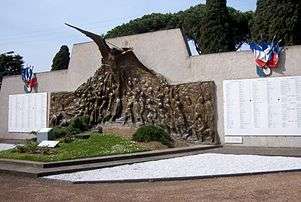Camille Alaphilippe
Camille Alaphilippe (1874 – after 1934) was a French sculptor.
Alaphilippe was born in Tours in 1874. At the age of 19, he was the pupil of Jean-Paul Laurens and Louis-Ernest Barrias to the École nationale supérieure des beaux-arts of Paris.
In 1898, at 24, he won the first great Prix de Rome in sculpture with a statue on the subject Caïn après la mort d'Abel poursuivi par la vengeance céleste or Caïn après la mort d'Abel entend la malédiction de l'Éternel.
He died in Algeria sometime after 1934.
Major works

The Monument aux morts de Philippeville, by Alaphilippe, transferred since 1969 to Toulouse
- Caïn après la mort d'Abel poursuivi par la vengeance céleste, 1898, École nationale supérieure des beaux-arts
- La Consolation, 1901
- Mystères douloureux, 1905, Mirabeau garden in Tours
- La Femme au singe, 1908, museum of Petit Palais in Paris
- Monument aux morts de Philippeville, Skikda in Algeria, transferred to Toulouse
External link

gollark: > why donset is just check the ids of the images<@576874001444503562> the discord message IDs are per MESSAGE, and also this does fuzzy match.
gollark: > wtf is that file extention, guhIt stands for JPEG File Interchange Format and is arguably more accurate than jpeg sometimes.
gollark: Who certifies freaks? Hmm.
gollark: Also, the orbital laser is probably not directly above the channel.
gollark: Mirrors aren't perfectly reflective.
This article is issued from Wikipedia. The text is licensed under Creative Commons - Attribution - Sharealike. Additional terms may apply for the media files.